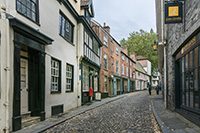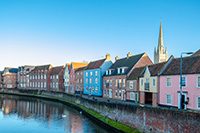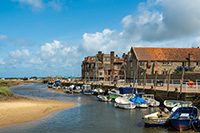Norfolk Coastal Towns and Villages
When you stay at Oak Cottage you will have easy access to the beautiful coastal towns and beaches of North Norfolk.
The travel times given below are assuming you are travelling by car from Worstead Barn.
Happisburgh – 22 mins
The famous red and white striped lighthouse in Happisburgh is the only independently operated lighthouse in Great Britain and is the oldest working lighthouse in East Anglia having been constructed in 1790. It is open to the public on occasional Sundays during the summer.
Bacton – 20 mins
The seaside village of Bacton, whose name is derived from ‘Bacca’s farm or settlement’, is located on the North Norfolk coast between Mundesley, which boasts a blue flag beach and Walcott, Norfolk. Bacton is known for its very quiet sandy beaches offering miles of walking along the beach and cliffs. The England Coast Path passes through the village and also the Paston Way long-distance footpath linking Cromer and North Walsham.
Sea Palling – 23 mins
Sea Palling Lifeboat Station is a voluntary-staffed and charitable-funded lifeboat station located in the village. First established by private funds in 1840, it was taken over by the Royal National Lifeboat Institution (RNLI) in 1858 and operated until 1931, when it was closed in a rationalisation of regional lifeboat stations. During its ninety one years of service, the station had one of the best rescue records of all the lifeboat stations in the UK. In 400 launches, 795 lives had been saved, a record bettered by only three other UK stations. Crews had gained four RNLI silver gallantry medals, with a replica of the one awarded to Tom Bishop still on show at St Margaret’s Church.
Revived in 1974 by local people through private funds, business and charitable donations, today the charitable Palling Voluntary Rescue Service runs a single nineteen foot Ocean Pro RIB, covering the area between Eccles-on-Sea and Winterton-on-Sea. Between mid-May and mid-September each year, the RNLI maintains a lifeguard station on the beach at Sea Palling, located just below the PVRS lifeboat station.
Waxham – 21 mins
Waxham is a lovely little village. It lies on the north-east coast of Norfolk. Buildings in the village include Waxham Hall, the 14th-century St. John’s Church and the 16th-century Waxham Great Barn. Waxham Hall is reputedly haunted by the ghosts of six members of the Brograve family, all of whom died in battle. It is said that an 18th-century owner of the house once invited them all to dinner. Waxham Great Barn, built about 1570, at 178 feet long is one of the largest barns of its age in the country. It has recently been restored and opened to the public. The village has an extensive beach backed by dunes. Many migrant birds pass through the area in spring and autumn and common cranes feed in fields near the village.
Mundesley – 23 mins
Mundesley is a popular seaside holiday destination due to its sandy beaches and has a number of holiday chalet and caravan parks and hotels. Just to the south of Mundesley on the road to Paston is a popular windmill, Stow Mill. The village was a popular seaside resort in Victorian times, benefiting from its own railway station which closed in 1964.
Mundesley has an historic golf course in the Mun Valley, designed with the help of six-times Open Champion Harry Vardon. Vardon convalesced at the nearby sanatorium while recovering from tuberculosis and his association with the course spanned many years. It is said that he scored his only hole-in-one on what is now the sixth. The course was reduced to nine holes when land was required for wartime farming, which was very important in that era.
Horsey Gap – 26 mins
Horsey Dunes is an extensive dune system on the east coast of Norfolk. It is owned by the National Trust and is within the Norfolk Coast AONB. It is sometimes known as Horsey Gap. To the south is the adjacent SSSI Winterton Dunes – it is possible to walk from one to the other.
The site is notable for a large colony of grey seals which breed there each winter.
The site, together with the adjoining Winterton Dunes, hosts the largest colonies of dark green fritillary and grayling butterflies in Norfolk. Other butterflies recorded from here in numbers include small copper and common blue.
Cromer – 27 mins
The town is notable as a traditional tourist resort and for the Cromer crab, which forms the major source of income for local fishermen. The motto Gem of the Norfolk Coast is highlighted on the town’s road signs.
Tourism developed in the town during the Victorian period and is now an important part of the local economy. The town is a popular resort and acts as a touring base for the surrounding area. The coastal location means that beach holidays and fishing are important, with the beach and pier being major draws. Visitor attractions within the town include Cromer Pier and the Pavilion Theatre on the pier. Close to the town’s pier the RNLI Henry Blogg Museum is housed inside the early 21st century Rocket House. The museum has the Cromer Lifeboat H F Bailey III (ON 777) as its centrepiece and illustrates the history of the town’s lifeboats and life boatman Henry Blogg’s most famous rescues.
The South American themed Amazona zoo park opened to the public in 2006 and is to the south of the town. The park covers ten acres of former brick kilns and woodland on the outskirts of the town and includes animals including jaguar and puma.
Caister – 28 mins
Caister’s history dates back to Roman times. In around AD 200 a fort was built here as a base for a unit of the Roman army and navy. However its role as a fort appears to have been reduced following the construction of the Saxon Shore fort at Burgh Castle on the southern side of the estuary in the latter part of the 3rd century. The name ‘Caister’ derives from the Anglo-Saxon word ‘ceaster’ meaning ‘Roman fort’
In the 1950s, a building near the south gate at Caister was excavated in advance of a housing development. These buildings do not appear to be military as they include a hypocaust and painted wall plaster as well as female jewellery, and it has been suggested that this building may have been an officer’s house. The site appears to have been abandoned in the 5th century, but 150 Saxon burials have been found to the south of the enclosure. The remains excavated in the 1950s are now managed by English Heritage and are open free of charge to the public as Caister Roman Site.
Hemsby – 26 mins
The tourist-based part of the village lies along Beach Road and is commonly known as Hemsby Beach. It features funfairs, crazy golf courses and children’s rides. The beach end of the road has cafes, shops and amusement arcades, while at the upper end are houses and accommodation parks, consisting mainly of chalets and caravans.
Great Yarmouth – 35 mins
Great Yarmouth’s seafront, known as “The Golden Mile” attracts millions of visitors each year to its sandy beaches, indoor and outdoor attractions and amusement arcades. Great Yarmouth’s Marine Parade has twelve Amusement Arcades within two square miles. In addition to the two piers, tourist attractions on Marine Parade include Joyland, Pirates Cove Adventure Golf, Castaway Island Adventure Golf, the Marina Centre, the Sea Life Centre, Merrivale Model Village and the Pleasure Beach and Gardens.
Sheringham – 32 mins
Sheringham town centre is centred on a traditional high street with a wide range of privately owned shops. On Saturdays throughout the year there is a popular market in the car park next to the railway station which attracts large crowds even out of the holiday season. The town also has a good selection of specialist shops such as second-hand books, antiques and bric-a-brac, fishing tackle and bait, a computer shop, a model shop, and arts and craft shops. The Sheringham Little Theatre has a wide range of productions on throughout the year including a well-established summer repertory season running from July to September, and a popular pantomime at Christmas; in the foyer is a coffee shop with display of art by local artists. There is a selection of food outlets, pubs, restaurants and a youth hostel.
An annual Cromer and Sheringham Crab and Lobster festival is held in May, and the town’s Carnival is held at the beginning of August.
Gorleston – 40 mins
The main attraction of Gorleston is its sandy “Edwardian Beach.” It has traditional seaside gardens and model boat pond. It also has a theatre opposite the pier called the Pavilion. The main shopping centre is on High Street. It has its own golf club. There is a lighthouse; lifeboat station and coast watch station on Riverside Road. In 2023 the beach was voted the best in Britain, and the 12th best in Europe.
Blakeney – 44 mins
Blakeney is a popular tourist resort during the summer months. The village has two large hotels, one in a historic building, and one with a modern main part but with also with a late 17th-century and 18th-century barn annexe, The Blakeney Hotel as well as having the alternative at the end of the Quay Road of the fifteen acre caravan site.
Blakeney offers a large range of activities including crabbing, fishing, canoeing and bird watching. In the area of marshland around Blakeney Point, owned by the National Trust, up to a hundred species of birds can be found throughout the year. Several pubs in the area serve food and real ale.
The North Norfolk Coastal Path travels along its quayside and varies between a path through salt marshes, raised promenades, sandy beaches and compact villages in this section.
Wells Next the Sea – 56 mins
This lovely town has long thrived as a seaport and is now also a seaside resort with a popular beach that can be reached on foot or by car. The beach is known for its long flat terrain, abstract sand dunes, varied beach huts and a naturist area situated to the west at Holkham. A landlocked brackish pool called Abraham’s Bosom was for many years used for pleasure boating and canoeing; it is all that remains of the West Fleet which once drained the Holkham marshes. The beach is backed by dense pine woods which are part of the Holkham National Nature Reserve. The woods comprise Scots pine, Maritime pine and Corsican Pine growing on sand.
More pinewoods exist to the east of the beach over the shipping channel at an area called the East Hills.
Lowestoft – 51 mins
Lowestoft is a fantastic traditional seaside resort with a great shopping centre. Lowestoft was first developed as a bathing site in the 1760s. The coast has been called the “Sunrise Coast”. The town’s main beaches are south of the harbour, where two piers, the Claremont and South piers, provide tourist facilities, and the East Point Pavilion the tourist information service. The beach south of the Claremont Pier is a Blue Flag beach. Lifeguard facilities are provided during the summer and water sports take place along the coast. Tourism is a significant aspect of the town’s economy.
Lowestoft features two major attractions, the first being Pleasurewood Hills Theme Park, situated on the northern edge of the town, while the second is the Africa Alive! Wildlife Park situated in the south at Kessingland. The natural attractions of the Broads and the River Waveney on the west edge of the town, also attract visitors and been the site for boat trips and water sports events, with companies such as Hoseasons operating hire boats from Oulton Broad.







